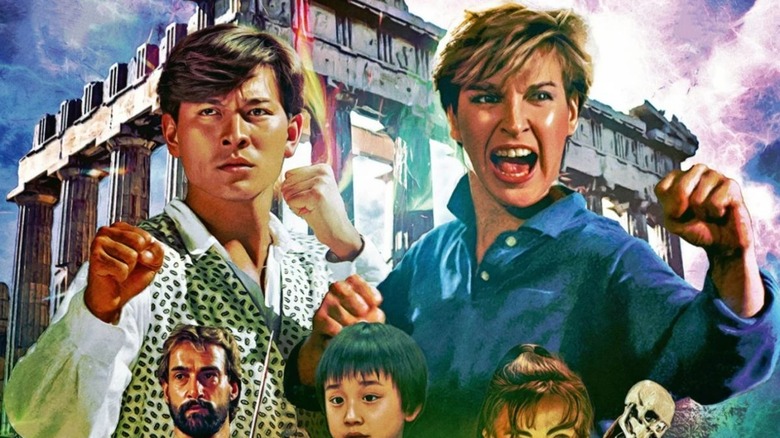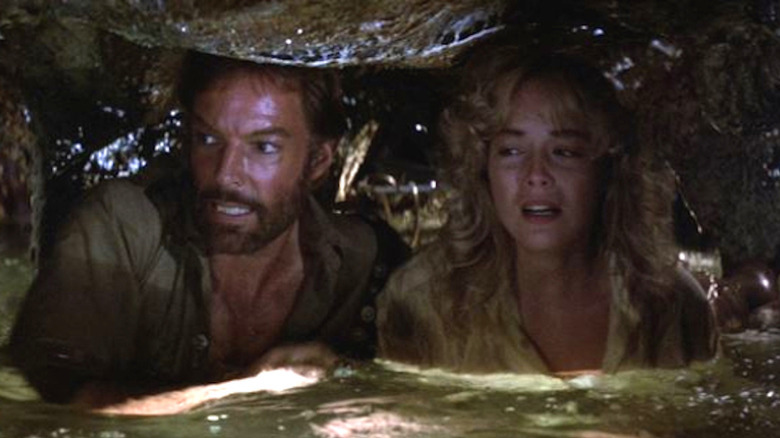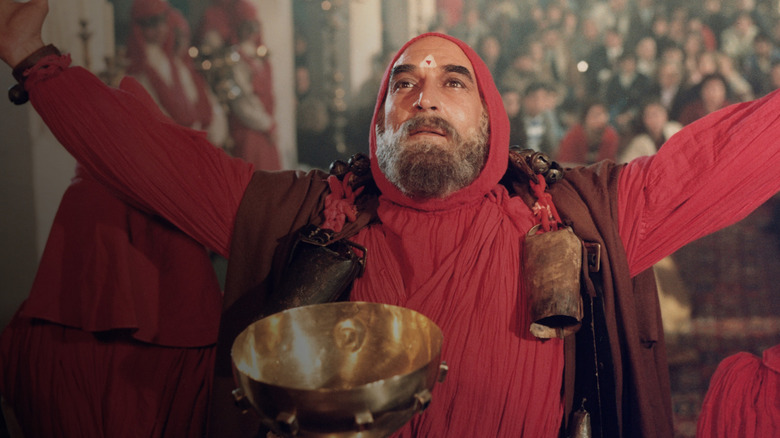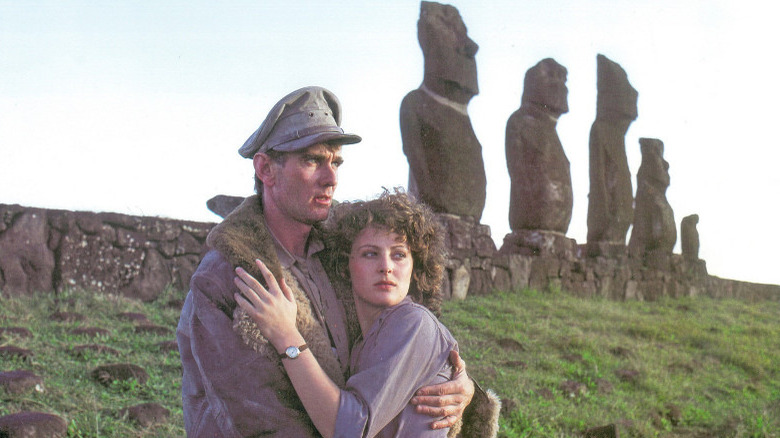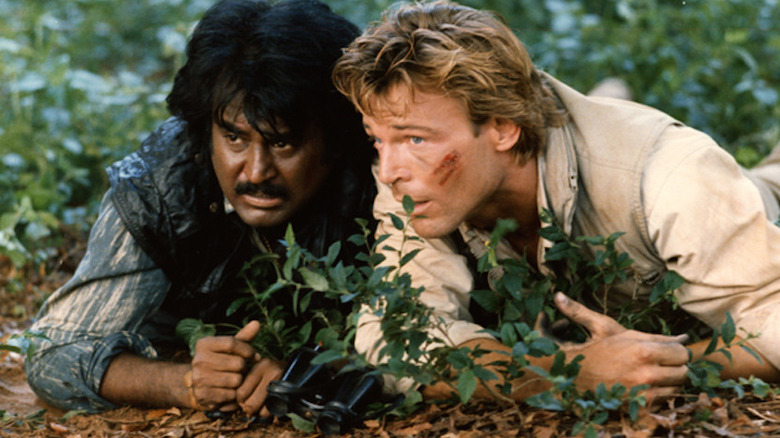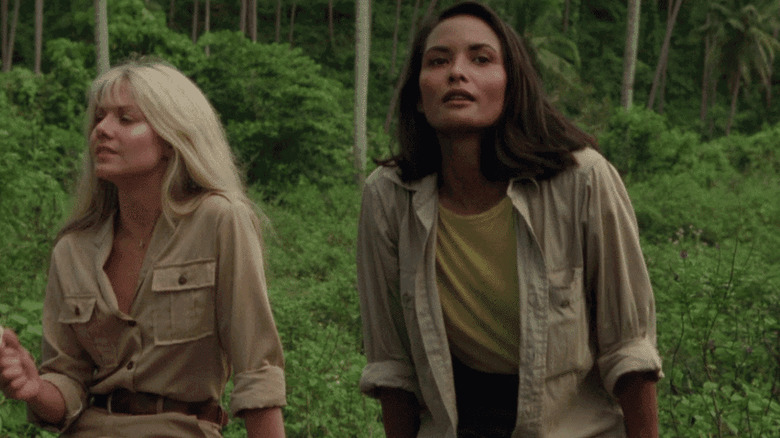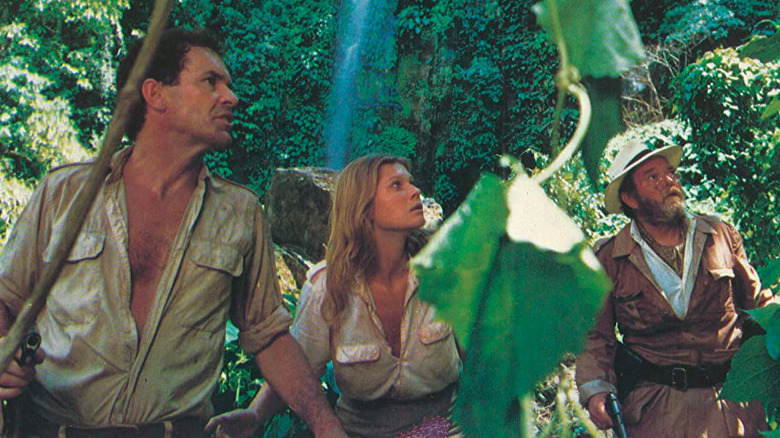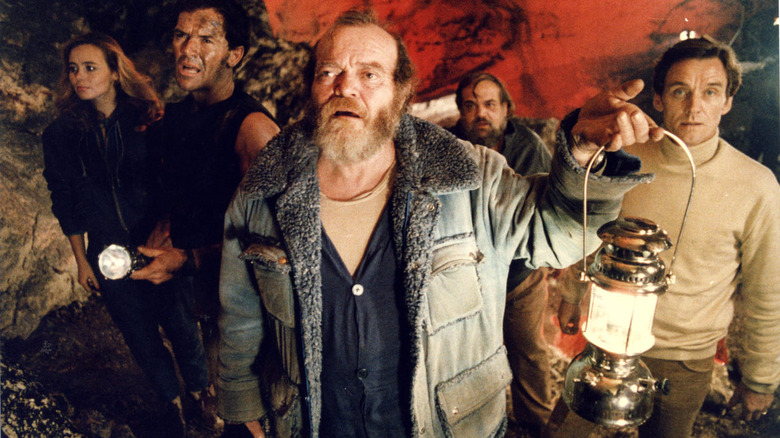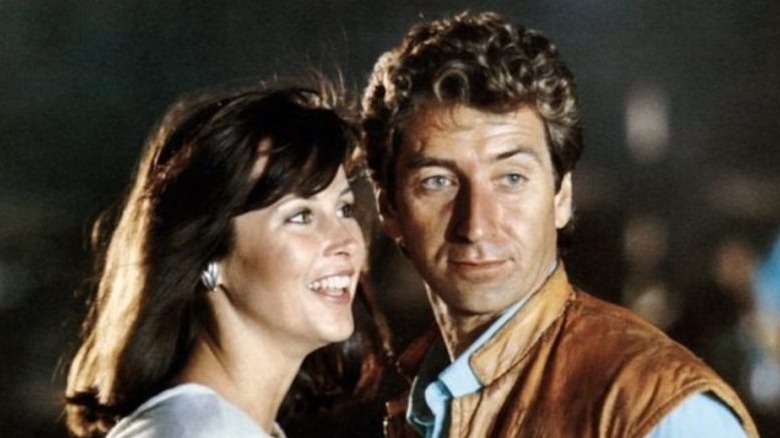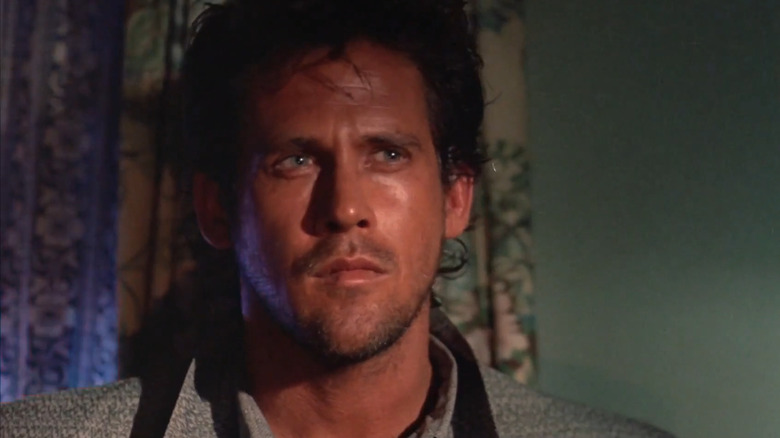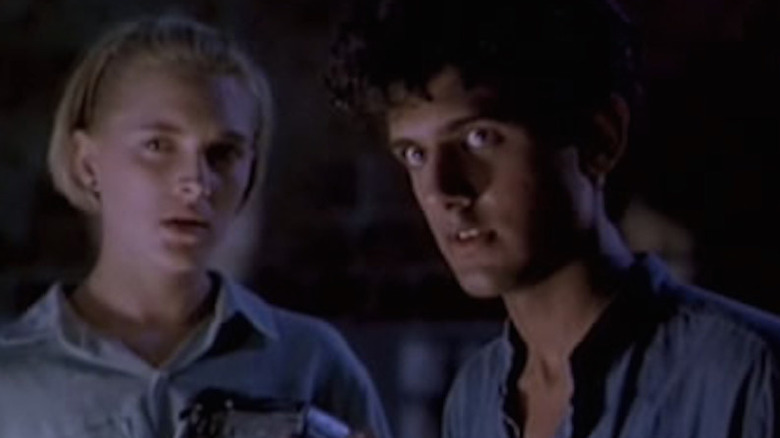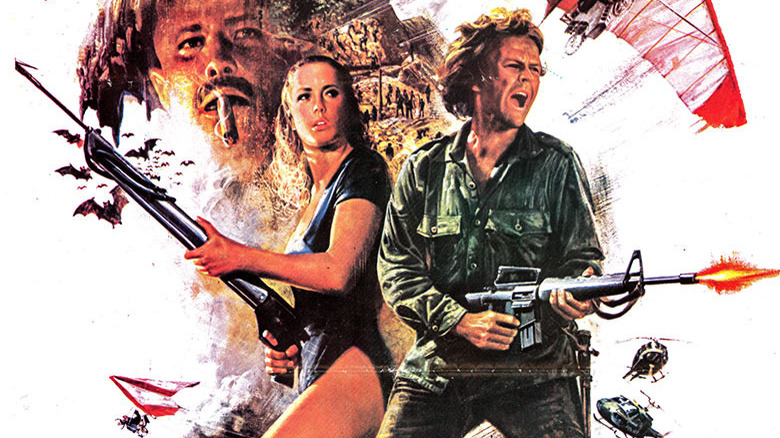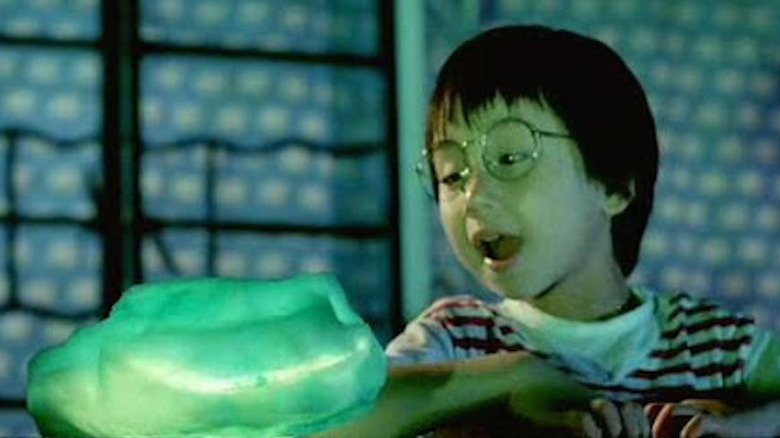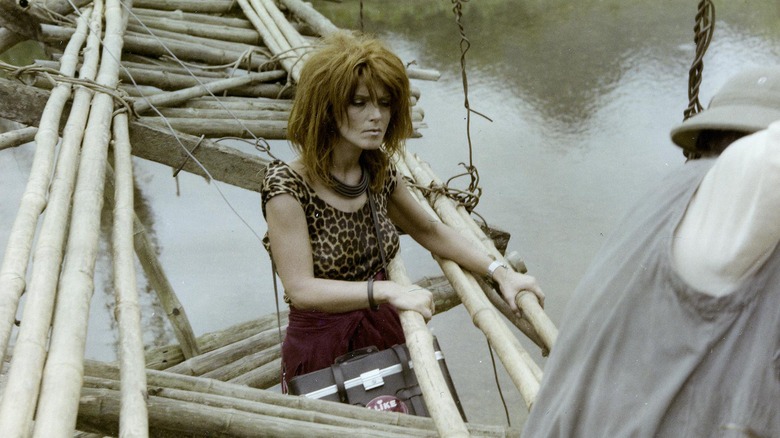The Most Ridiculous Indiana Jones Ripoffs That Actually Happened
When it comes to the history of motion pictures, the rule of thumb has always been that if a movie is a major success, it's only a matter of time before other production entities start generating their own versions to siphon the original's acclaim (and box office). That principle has given us enjoyable coat-tail riders like the original "Battlestar Galactica" (which drew on the popularity of "Star Wars") and Lucio Fulci's "Zombie" (a nod to George Romero's "Dawn of the Dead") as well as bald-faced knock-offs like Roger Corman's "Carnosaur" (a threadbare nod to "Jurassic Park") and the entire mockbuster output of The Asylum.
International imitations of popular American movies, however, are a unique entity unto themselves. Foreign producers have been known to take the "catch me if you can" approach to wholesale swiping of plots, characters, and even complete scenes from domestic blockbusters, resulting in Japanese Spider-men, Turkish Captain Americas, Italian Xenomorphs, and Bollywood Freddy Kruegers. Of course, when George Lucas and Steven Spielberg's 1981 blockbuster "Raiders of the Lost Ark" became a smash, it was not immune to these movie copycats, who attempted to capture its high adventure and thrilling special effects using outside-Hollywood resources.
Here is a breakdown of some of the oddest, most offbeat and utterly ridiculous Indiana Jones rip-offs that actually played to audiences. To paraphrase Indiana Jones: many of these films seemed to be making it up as they went along.
King Solomon's Mines (1985)
Cannon Films, budget-minded producers behind numerous Chuck Norris and Charles Bronson films in the 1980s, turned their attention to "Raiders" knock-offs on several occasions, including the uninspired Norris vehicle "Firewalker" and "Sahara" with Brooke Shields. Their crowning achievement in this regard — such as it is — was a 1985 adaptation of H. Rider Haggard's 1885 adventure novel "King Solomon's Mines." The Cannon take on the book — one of many screen adaptations filmed between 1937 and 2004 — clearly takes its cues from "Raiders," with an onslaught of breakneck thrills (biplane battles, lion attack) and a script dotted with punny lines.
Cannon got veteran director J. Lee Thompson, who helmed classic adventures like "The Guns of Navarone" in the 1960s, to oversee their "Mines," and he handles the pulp action like a pro. But he can't save the film from its relentless goofball humor: scenes with stars Chamberlain and Sharon Stone in a cooking pot surrounded by cannibals are cartoon-ridiculous, as are villains broadly played by John Rhys-Davies and Herbert Lom ("The Pink Panther"), as well as cringe-inducing stereotyping of ethnic characters.
This pursuit of cheap yucks did not endear the '85 "Mines" to fans or critics, but that reaction didn't stop Cannon from issuing a sequel, "Allan Quatermain and the Lost City of Gold." Part of the reason for that release was because the film was already in the can: Cannon shot it back-to-back with its predecessor. The sequel dropped the gag lines, but seemed to up the production's ineptitude.
Treasure of the Four Crowns (1983)
Released during the height of the '80s 3-D boom, the U.S./Spanish/Italian action-adventure film "Treasure of the Four Crowns" made no bones about imitating "Raiders"; the film's treasure-hunting hero (Tony Anthony) has a run-in with an oversized boulder, and heads do melt (among other things) in its conclusion. Where the two pictures dovetailed was, of course, the 3-D effects, of which there are plenty in "Four Crowns," and hurled at the viewer at an exploitative pace that verges on hysterical.
Anthony — an American actor and award-winning producer who appeared in a string of enjoyable spaghetti Westerns — co-writer Lloyd Battista, producer/co-star Gene Quintano, and director Ferdinando Baldi scored a modest 3-D hit in 1981 with the Western "Comin' At Ya!" That film set the template for their approach to 3-D by hurling a small department store's worth of implements at the screen; "Four Crowns" ups the ante by tossing balls of fire, severed heads, skeletons, dogs, and even the rubble of a demolished castle at viewers.
Lacking the budget to pull off "Raiders"-quality effects didn't keep Anthony and crew from attempting a visual assault on the senses in the film's finale. Having finally secured jewels from two of the crowns (only three in total are featured in the film), Anthony's face melts, his head spins around, and flames shoot out of his shirtsleeves. Sure, it doesn't have the visceral punch of the "Raiders" ending, but you still have to appreciate their ragged-but-right effort.
Sky Pirates (1986)
Australia's entry into the "Raiders" rip-off pantheon was "Sky Pirates," which also screened as "Sky Bandits" and "Dakota Harris." The action-fantasy is voracious in its absorption of not only material from "Raiders" but other films as well: an extraterrestrial/time travel element borrowed from (among others) "The Philadelphia Experiment," which is directly name-checked in the script; an off-kilter nod to "The Deer Hunter" in an impromptu game of Russian Roulette; and so on.
The relentless sampling of other films and genres obscures some positives in "Sky Pirates," including impressive location shooting (on Easter Island, among other places) and a thunderous score by Brian May, who wrote the soundtracks for the first two "Road Warrior" titles. Australian soap star John Hargreaves does well with the hat-wearing, square-jawed requirements of the role, and there are a few action setpieces that hold attention, though a scene in which Hargreaves decides to repair the wing of his plane — while in mid-air! — undoubtedly stretches credulity, even in a film fueled by pure fantasy.
Blink and you'll miss Hugo Weaving of "Lord of the Rings," "Matrix," and "Captain America: The First Avenger" fame in an uncredited bit role.
Bloodstone (1988)
The US/Indian production "Bloodstone" — not to be confused with the crummy sequel to the low-budget vampire series "Subspecies" — is a carbon copy of a carbon copy, borrowing heavily from "Romancing the Stone," itself a high-end knockoff of "Raiders." While "Bloodstone" is anything but high-end, it does use its Indian locations to great effect for big-budget production polish.
The framing story is inconsequential, following newlyweds Brett Stimley (who played JFK in both Zach Snyder's "Watchmen" and "Transformers: Dark of the Moon") and Anna Nicholas (now an author, director, and playwright) after they accidentally obtain the titular ruby, which puts them in the crosshairs of suave villain Christopher Neame (whose character possesses the amazing name Ludwig Van Hoeven). The film's primary raison d'etre is to serve as the English language debut of Tamil superstar Rajinikanth, who plays a cab driver caught up in the jewel hunt.
Though his appearance suggests anything but "action star," Rajinikanth delivers the sort of relentlessly over-the-top performance that earned him the adoration of millions of fans in India, where his popularity is roughly on par with Jackie Chan's in Asia during the height of his Hong Kong film period. His charisma-on-overdrive turn and frantic assault on action scenes (every scene, really) elevates "Bloodstone" past its limp premise and the grisly sight of comedian Charlie Brill in brownface as a bumbling Indian police inspector.
Invaders of the Lost Gold (1982)
The lost gold referenced in the title of 1982's "Invaders of the Lost Gold" is treasure stashed in a remote jungle by Japanese soldiers during World War II. Said invaders are one of the most motley crews ever to populate a "Raiders" knockoff: grizzled American stars Stuart Whitman and Woody Strode, British actor turned exploitation vet Edmund Purdom, Indonesian actress Laura Gemser (the star of the "Black Emanuelle" films), and former Bond villain Harold "Oddjob" Sakata. This misbegotten lot spends much of the running time falling victim to unseen (and unexplained) dangers, battling rubbery crocodiles, and punching each other out before said lost gold is ever invaded.
A threadbare adventure, "Invaders" putters towards what it hopes audiences will consider a slam-bang ending (it's not), occasionally stopping the action for a battle with disinterested Filipino actors playing cannibals. In an interview on the recent Severin Blu-ray release of "Invaders," director Alan Birkinshaw noted that the film's script was written during filming.
The Hunters of the Golden Cobra (1982)
Italian "Raiders" clone "The Hunters of the Golden Cobra" offers two treasure hunters for the ticket price of one: New Zealand-born actor David Warbeck (a staple of European genre films, including Lucio Fulci's "The Beyond") as a tough American GI and British actor John Steiner (a go-to bad guy in many Eurocult films, and now a real estate agent in the US) as a stiff-upper-lip English military officer. Their partnership — which is wrung dry of all the potential odd couple clashes — is assigned to secure the title statue, a sacred object with vaguely-detailed supernatural powers.
Director Antonio Margheriti — a veteran of Italian genre filmmaking whose career began in the early 1960s — actually details the duo's second attempt to retrieve the Golden Cobra, since their first try at a Japanese military base is a total bust. Despite this, they're sent out for a second attempt, this time with archaeologist Luciano Pigozzi and his niece, Almanta Suska, in tow (and did we mention that Suska is a dead ringer for the high priestess of the Golden Cobra's cult?).
The action is frantic, the plot proceedings implausible, and the budget gaps all too visible in "Golden Cobra," which wasn't enough to stop Margheriti from taking two more passes at "Raiders": "Ark of the Sun God" and the completely deranged "Jungle Raiders," which features far more helpful snakes than the ones featured in "Golden Cobra."
The Ark of the Sun God (1984)
Fans of miniature effects will find "The Ark of the Sun God" a veritable showcase for action setpieces built entirely from tiny cars and cityscapes. The Italian-produced, Turkish-lensed actioner — the second of three "Raiders" carbons overseen by director Antonio Margheriti — re-teams David Warbeck and John Steiner from "Hunters of the Golden Cobra." Here, as before, Warbeck is the gritty rogue (a safe cracker by trade) and Steiner the English second fiddle in need of a hero for a dangerous mission. The treasure in "Sun God" is the scepter of Gilgamesh, the hero of Mesopotamian myth, which lies inside an impenetrable tomb.
Margheriti keeps the pace at a brisk clip, especially after nefarious types try to kidnap Warbeck's girlfriend (Susie Sudlow). Their struggle unfolds through several car chases and a final face-off in the tomb, which Margheriti depicts almost entirely through miniature effects. It's a gambit that might have worked when Margheriti was directing science fiction and sword-and-sandal films in the 1960s; here, there's no mistaking the toy cars and cardboard buildings for what they are.
Jake Speed (1986)
Independent filmmakers Andrew Lane and Wayne Crawford, who scored critical hits and quasi-cult-classics with "Valley Girl" and "Night of the Comet," took a swing at "Raiders" material with their tongue-in-cheek adventure "Jake Speed" in 1986. The picture has an amusing premise: when her sister is captured by slavers in Africa, Karen Kopins ("Dallas") sees the only option for rescue as Jake Speed, an apparently fictional hero pulp adventure novels. The film then mines this concept for all the humor and big-bang action it can provide.
The flick has its share of punchy action setpieces and features two terrific actors in supporting roles — John Hurt ("Alien") as the lead villain, and Dennis Christopher ("Breaking Away") as Speed's assistant/scribe — but as director, Lane can't keep up the breakneck pace necessary for this sort of movie. He's also made the unfortunate decision of casting Crawford as Speed. While Crawford (who died in 2016) has the right degree of self-deprecating humor, he is a non-presence in the action material and attempts at romantic scenes with Kopins.
At best, he comes across as smug, which works if the dialogue is amusing (see "Big Trouble in Little China"). Unfortunately, the gags are so leaden they upend the frothy-fun tone the filmmakers sought.
River of Death (1989)
Cannon once again applied the "Raiders" template to 1989's "River of Death," a UK/German adaptation of suspense specialist Alastair MacLean's 1981 adventure novel of the same name. In truth, Cannon didn't have to work very hard to make this a ridiculous "Raiders" rip-off: the source material — not MacLean's best work — was already made of heavy pulp, with secret German hideouts, cannibals, and giant snakes all playing a role in the plot. All Cannon did was bring aboard in-house action star Michael Dudikoff to handle hero duties, and tap a small crew of aging cult favorites — including Donald Pleasance, Robert Vaughn, and L.Q. Jones — to serve as the bad guys.
The results, overseen by late director Steve Carver ("Lone Wolf McQuade"), deliver in the low-budget action department, piling on cannibals, pirate attacks, and mad science — and Pleasance, Vaughn, and co-star Herbert Lom bite off sizable chunks of the scenery with gusto. Bu its premise gets no less ludicrous in the transition from page to screen, and according to Carver, the film was an absolute nightmare to make.
The Seventh Coin (1993)
The 1993 U.S/Israeli action-thriller "The Seventh Coin" has striking location photography of Israel's antiquities and cities, a fast pace, and old-school Hollywood star power in its lead villain, Peter O'Toole. What it doesn't have, however, is much of a plot or compelling heroes to fuel it. As a result, "Coin" feels like a kids' movie with flashes of violence.
O'Toole plays a British soldier obsessed with finding the titular object, a coin minted by the legendary King Herod. His mania for finding the coin is spurred in part by his fragile mental state, which is anchored around a belief that he is, in fact, the reincarnation of Herod. Said mania allows him to pursue American tourist Alexandra Powers and Israeli thief Navin Chowdhry, who have come into possession of the seventh coin in one of many plot twists that strain credulity.
Who was the intended audience for "Seventh Coin"? Action fans were undoubtedly disappointed by the mild chase sequences, and teen romance viewers most likely found the relationship between Powers and Chowdhry disappointingly sluggish. Thriller audiences were probably irked by constant breaks in the action to shoehorn in a subplot involving Israeli cop Ally Walker, who wants to please her captain dad (John Rhys-Davies) by tracking down the coin, and admirers of O'Toole's storied body of work may have winced to see this exceptional actor ham it up in a cartoon villain role. Perhaps "The Seventh Coin" is best appreciated by fans of actor/teacher Whitman Mayo — Grady on "Sanford and Son" — who turns up as a coin store owner.
Gold Raiders (1982)
Stop us if you've heard this one before: a plane carrying a fortune in gold goes down in a remote stretch of jungle (in this case, it's Thailand), and a hard-bitten crew of mercenaries sets out to recover the treasure. All that is on the menu in 1982's "Gold Raiders," but the Thai feature also has a few eccentric wrinkles on the formula.
Chief among these is the super-powered motorcycle piloted by the team's leader, played by Robert Ginty of "Exterminator" fame. The bike is tricked out with missile launchers and an overhead canopy that at first blush, looks decidedly phallic. But while being pursued by minions, one of the film's many bad guys — a sadistic general with a wooden leg — reveals the canopy's true nature: it's a hang glider which allows its user to sail away from danger (though the bike's wobbly construction seems to put him into a frying pan/fire situation).
Excessively gloppy violence — lots of blood squibs triggered by axe, knives, etc. to secondary characters' faces — off-kilter dubbing, and a face-off with giant bats tricked out with flashing toy eyes make "Gold Raiders" one of the most amusing entries in the "Raiders" rip-off subgenre.
Magic Crystal (1986)
The 1986 Hong Kong adventure-fantasy "Magic Crystal" is not only one of the most densely and absurdly plotted movies to come out of that region (which is saying a lot), but also one of the most omnivorous rip-off titles of the 1980s, borrowing not only from "Raiders" but also "E.T." How those two films meet in the middle of a martial arts/espionage/action-comedy is part of the perverse pleasure of "Magic Crystal."
In short: undercover crime fighter Andy Lau and his sidekick (played by writer-director Wong Jing) are pulled into the orbit of various spies —including stateside agent Cynthia Rothrock and KGB operative Richard Norton — on the trail of a mysterious briefcase containing the title rock. Said item is not only extraterrestrial in nature but also alive and conversant (via psychic abilities) with Lau's deeply aggravating nephew Bin-Bin Siu.
The action coalesces into a very Indiana Jones-like scenario, with Lau and others navigating a temple filled with elaborate traps. The budget doesn't allow for them to be particularly clever or diabolical, but the shortcomings in this department are compensated by some terrific fights choreographed by Leung Siu Hung ("Ip Man"). The less said about the gooey-looking alien inside the magic crystal, however, the better.
Curse of Snakes Valley (1988)
Running through a "Raiders" rip-off checklist, "Snakes Valley" ticks all the boxes. Lost artifact? Check (a vase stolen from a monastery in Vietnam). Hidden treasure? Check (a map inside the vase which leads to a remote tomb). Perilous journey? For sure (lots and lots of snakes, of course, but also rickety rope bridges and general tropical danger). Bad guys? A few (industrial spies). And, most importantly, a gauntlet of deadly traps and threats en route to the treasure?
Well, there are stone idols that shoot lasers at heroes Krzysztof Kolberger and Roman Wilhelmi, the roomful of aforementioned snakes, a guardian monster (played by a very rickety rod puppet), Buddhist monks with throwing stars, and a dead alien at the end of the whole adventure. There's also an exhausting amount of trekking-through-the-jungle scenes, made exponentially more delirious by female lead Ewa Salacka's extremely inappropriate outfit.
Director Marek Piestrak — a former intern for Roman Polanski before helming several out-to-lunch adventures like "The Wolf" — makes excellent use of location shooting in France and Vietnam, and displays a fun go-for-broke attitude towards action and special effects that require far more budget and expertise than this picture can afford. Long unavailable for viewing to Western audiences, "Curse of Snakes Valley" has, in recent years, made the rounds at various festivals.
